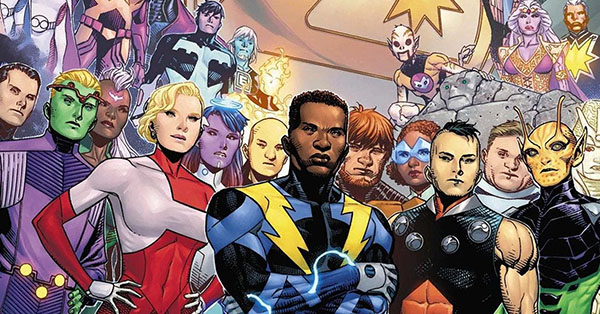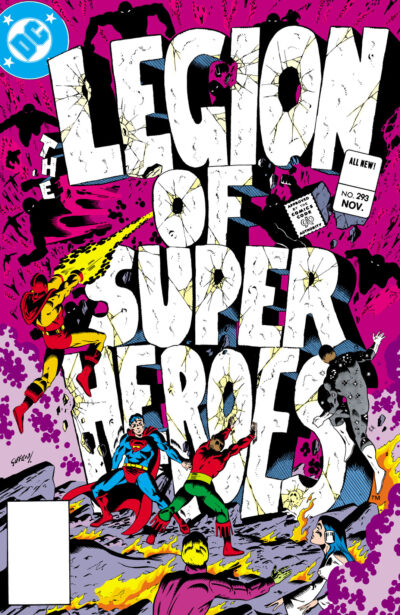I’m happy to announce that my Guide to Legion of Super-Heroes (LOSH) is now available to all CK readers as part of the Crushing Comics Guide to Collecting DC Comics! This guide covers ever Eternals series and every major Eternals character!
This Guide to Legion of Super-Heroes was originally launched back in June thanks to the ongoing support of the legion of outstanding Patrons of CK. It is newly updated with EVERY Legion title and EVERY Legion collection EVER published, plus links to buy them all physically and digitally or read them online at DC Universe Infinite.
Guide to Legion of Super-Heroes (LOSH)
If you’ve never read Legion of Super-Heroes before, here’s the briefest crash-course through their history that I can manage (with apologies to Legion super-fans):
(Longtime Legion fans, please forgive me.)
The Legion of Super-Heroes (LOSH for short) is a 30th Century intergalactic superhero youth congress and peace-keeping force. They have the cosmic scope of Green Lantern Corps, the teenage drama of Teen Titans, and the massive cast the entire X-Men franchise all rolled into one or two books at a time.
In 1958, in the original, Pre-Crisis DC Universe, three heroes from the 30th century Legion travelled back to the past to meet their personal hero, Superboy (who at the time was literally the kid version of Clark Kent). Cosmic Boy, Lightning Boy, and Saturn Girl brought Clark to their future, where he joined the Legion. Decades of comic adventures ensued, including Superboy sharing his ongoing title with the Legion in the 1970s before they spun off into their own blockbuster title in the early 1980s.
After Crisis on Infinite Earths, that origin became awkward to reconcile with John Byrne’s post-Crisis Superman reboot. Around the time of Crisis, DC killed the Legion’s Superboy and then fast-forwarded the plot of the 30th Century to a new “Five Years Later” extension of their existing continuity in 1989.
By the time Zero Hour rolled around in 1994, the accumulated continuity of LOSH plus the aging characters resulted in a dark and less teen-oriented title. The present day ripples in continuity created by Zero Hour became a tidal-wave by the time they hit the 30th Century, which lead DC to kick off “Reboot Continuity” in the middle of two ongoing LOSH series. This new status quo somewhat resembled the teenaged LOSH of the mid-80s, but with Conner Kent’s Superboy as a member rather than literal Clark-as-Superboy (who no longer existed as such).
Sales were dropping by the mid 00’s despite a beloved multi-title run across several Legion books by Abnett & Lanning, including the introduction of Legion Lost. In 2004, DC decided to wipe the slate completely clean and restart LOSH as if no Legion comics had existed previously. This was “Threeboot Continuity.” It was originally meant to stay contained to the 30th Century, but within a year it added present-day Supergirl to the cast.
When Final Crisis arrived 2008-2009, DC’s current crop of writers wanted to get back to the original, classic LOSH continuity without having to deal with all of the baggage of the “Five Years Later” version. Instead, DCy had all three versions of the Legion meet up during the event, and afterward they continued to “Preboot Continuity.” Basically, it filled in the gap before “Five Years Later.” This continuity continued into New 52 in 2011, with the franchise finally coming to an end in 2013 after over 40 years of nearly-continuous publication.
The Legion all but disappeared from DC continuity, aside from appearances in Convergence and occasional Easter Eggs.
Then, during the Rebirth Era in 2018, Brian Michael Bendis literally re-wrote the original Legion of Super-Heroes origin story where heroes of the 30th century Legion travelled back to the past to meet their hero, Superboy. Only, this version of Superboy is Clark Kent’s son Jon! This led to the Legion’s Rebirth Continuity, starting with an ongoing title in 2020.
And now you understand the sordid publication history of the Legion of Super-Heroes about as well as I do! Find the comics that fit into every one of those eras of continuity in my Guide to Legion of Super-Heroes (LOSH).

